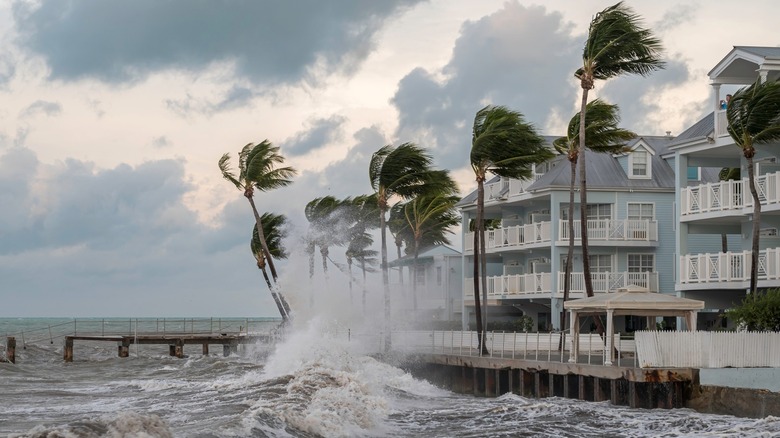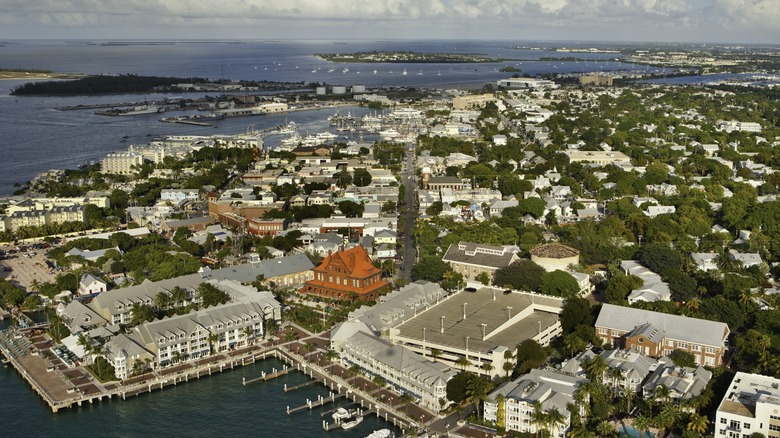How Dangerous Really Is It To Visit Key West During Hurricane Season?
Key West entices travelers with stretches of golden sand that vanish into a great expanse of cobalt blue waters. Flourishing palms sway in a gentle ocean-scented breeze, the rustling of their leaves creating a pleasing melody as you lay back in your beach chair, a refreshing frosted beverage in hand. It's the idyllic vacation that most would want, especially waterbugs who never want to leave the ocean.
However, there are some who, for as much as they want the picturesque Key West views, remember names like Irma, Wilma, George, and Betsy. Unless you're from the Keys or keep up on weather history, chances are those don't mean much. However, for the cautious and aware, they may be a significant reason why a trip to Key West is off the vacation-planning table indefinitely.
Florida is known for being prone to hurricanes, and those four are some of the worst in the state's recent history. That said, there is a disparity between areas deemed to be at severe risk and those less likely to see hurricane activity. According to FEMA's hurricane risk index, counties like Union and Gilchrist are at a "relatively low" risk, but Key West, situated right in the Gulf, is, unsurprisingly, a "relatively high" risk area. That still may not sway some travelers, particularly because being at risk of hurricane activity doesn't necessarily mean your life is in danger. However, the index doesn't measure the likelihood of a hurricane making landfall. Rather, it's a mathematical equation that calculates the threat of a hurricane after it has made landfall.
Is it dangerous to visit Key West during hurricane season?
The equation for FEMA's Hurricane Risk assessment is the expected yearly monetary loss due to hurricane damage multiplied by the region's vulnerability and divided by community resilience. According to FEMA, community resilience measures preparedness in a specific region and its ability to "adapt to changing conditions, and withstand and recover rapidly from disruptions." Monroe County, which includes Key West, has a relatively high social vulnerability, which suggests it is a dangerous place to be when hurricanes are a possibility.
Another factor to consider is how frequently hurricanes hit Key West. After all, it could be susceptible to damage from heavy winds and rain, but if hurricanes are infrequent, the risk of being in danger is lowered. According to the National Oceanic and Atmospheric Administration (NOAA), two of the worst hurricanes to hit Key West, Irma (2017) and Wilma (2005), occurred in the past 20 years. Additionally, since 2005, Key West has experienced the effects of five significant weather systems. One of them, Hurricane Ian in 2022, passed about 70 miles offshore and still caused flooding and hazardous conditions. While those numbers aren't astronomically high, they should give pause to anyone considering a Key West vacation while hurricane season is underway.
During a hurricane, Key West is at a high risk of flooding, as it sits only 18 feet above sea level. According to the National Weather Service, 2005's Hurricane Wilma resulted in the deaths of dozens of people and left more than half of the island submerged and flooded due to high storm surges.
When is the best time to visit Key West?
Generally, you want to avoid visiting Key West between the beginning of June and the end of November. Much like it is in the Caribbean, that period is considered hurricane season in Florida, with mid-August to mid-October typically showing the highest chances for activity. That still leaves an entire half a year to choose from and still take advantage of the beauty of the oceanfront city and its thrilling activities like diving and kayaking. Based on weather data recorded from 1991 to 2020, spring (March through May) has experienced moderate average temperatures hovering between the low-80s and low-70s and a reduced average precipitation. Winter months tend to be a little dryer, but you're more likely to experience chillier temperatures.
If you're worried about crowds, bear in mind that winter can be surprisingly busy as travelers like to escape their frozen tundras to the moderate temperatures of Key West. Based on tourism data from 2008 to 2020, December through February or March typically sees an influx of travelers heading to the Florida city, with hotel occupancy rates declining by April and May. If you're worried about the Gulf of Mexico being too chilly to swim in right after winter, don't be. By April, water temperatures start rising into the 80s, which is perfect for dipping your toes in after relaxing under the Florida sun for a spell.


